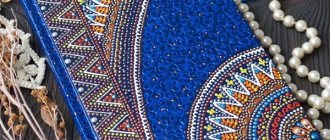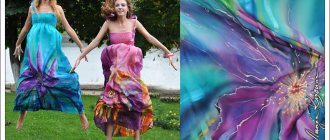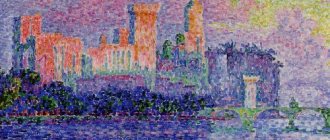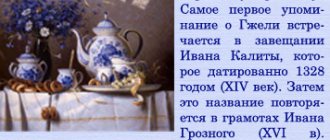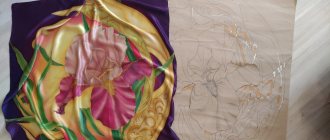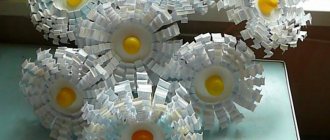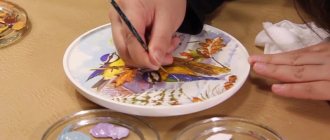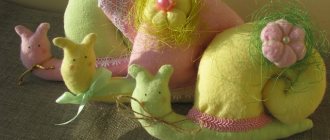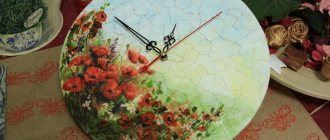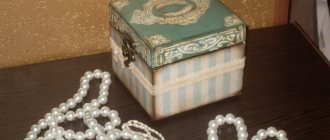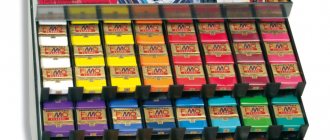Dear friends, subscribers and blog visitors!
In my creative work I use almost all known glass painting techniques with stained glass paints. Don’t be surprised, it’s not difficult, because there are not so many of these techniques: contour, non-contour and multi-layer.
Sometimes dot painting on glass is also used - this is perhaps the only basic technique that can be combined both with stained glass painting and separately as a point-to-point on other surfaces
Glass painting technique
In the photo above, I am working on a glass painting. The most amazing moments in the life of an artist are the moments of creating works... on glass, canvas or wood. Let's take a closer look at these techniques today and figure out what the specifics of each of them are and what opportunities they open up for artists. You will see that due to the effects obtained when using each technique, you can create completely different stained glass paintings with the same paints.
Let's start with the most common...
Contour painting technique
Its essence lies in the fact that first a contour painting is done on glass , a sketch of the work is created, and then the spaces between the contours are filled with paints, as a result of which a picture is born.
The drawing is outlined with a relief outline, preferably from the same company that makes stained glass paints. If the surface is large enough, stained glass lead tape is used, which plays the same role as the outline - it does not allow the stained glass paint to mix and strictly adhere to a certain place.
Examples of masters in stained glass painting using contour
This is a matter of your taste... If you want to make the divisions in the drawing wider and similar to those in a real stained glass window, then choose stained glass lead tape. If you want your work to be airy and light, choose a contour in a tube.
The height of the outline depends on how much paint you plan to pour onto the glass. But the denser the paint, the less transparent it is.
Tip: stained glass paint is an amazing material; you can use it to create colorful works, and not only on glass. Practice on small pieces of glass with different densities of paint on the glass using different height outlines…. Perhaps you will discover something new for yourself!
In principle, all life is built on experiments. Experiment and live life to the fullest. And as Aristotle correctly noted: “To live means to do things, not to acquire them!”
You can get your hands on stained glass painting on small glasses, plates and vases
The advantages of this technique: the ability to see a sketch of the painting before filling it with colors, a certain schematic nature that allows you to break the process into separate stages, and the characteristic “stained glass” appearance of the final work.
Watch the video story “ How you can decorate an interior with stained glass painting” using the example of a large painted stained glass window, made to order by me, and take note.
Dot painting technique
The types of images depend on the choice of painting technique. Thanks to the dot technique, you can work with contour stained glass paint on the surface. The sequence of work is as follows:
- Draw the outlines with a simple pencil.
- Points that have the same dimensions at the same distance are drawn along the contour.
- The technique requires drawing a picture from general elements to specific ones, immediately a large image, then smaller details. The size of the coloring dots will depend on how hard you pressed the tube.
- When using a contour image, you need to paint the details along the contour of the drawing.
- To perform detailed drawings, use thin brushes or contour paints in a tube.
To perform stained glass painting you will need skill and accuracy. Paints in tubes are not as thick as acrylic paints, so they can spread over surfaces.
We hope that the information received will help you master this interesting technique. Let painting with colorful stencil paints bring you real pleasure from the creative process!
Stencil painting of a glass (1 video)
Variety of stencils and templates (23 photos)
Non-contour technology
The peculiarity of stained glass paints is that they spread strongly over the glass. If you use them without contours, you need to control this spreading and, in fact, create a picture precisely due to it.
When applied, paints not only spread, but also mix with each other, creating new shades, stains and unclear boundaries. It turns out a little like a typical watercolor, only varnished.
Here is an example of stained glass abstraction, this is a blank for continuing the painting
This technique is more difficult than the previous one and takes a long time to master. It varies greatly depending on the brand of paint and the degree of dilution, and the application itself is difficult and time-consuming.
By the way, if you have not yet decided what stained glass paints you would like to use to paint your products, then a review article on stained glass paints can help you with this.
In general, this is a technique for curious people. It is best to use varnish stained glass paints to create beautiful paintings using the non-contour technique; they open up more opportunities in the world of stained glass painting.
By the way, these two techniques can be combined. For example, inside a large element in an outline you can make a pattern in a non-outline manner. And of course, flowers turn out especially beautiful when the spreading of stained glass paints creates amazing patterns inside the flower!
In a master class on painting a glass table, I show all the nuances of such work. The photo below clearly shows how beautiful spreading is created in this way.
Fragment from a lesson on painting a table
You can purchase a video tutorial on stained glass painting a glass table Also in this lesson I additionally show the technique of gilding with gold leaf, since gilding complements this work.
As you know, hand made is a special type of creativity and it is popular all over the world, because many people like to decorate the interior with their own hands.
Second option
For work you will need the following tools and materials:
- Candlestick made of glass;
- Acrylic paints;
- Acrylic outline;
- Paint that gives glass a matte appearance;
- Set of brushes;
- Ordinary alcohol;
- Double-sided tape;
- Foam sponge;
- Cotton buds;
- A set of toothpicks;
- Cotton pads.
Step-by-step description of the work.
First of all, it is necessary to prepare the glass surface for applying paint. To do this, wipe it with alcohol. We decide what will be depicted on the candlestick. You can also use a ready-made stencil or draw a picture yourself. We glue the finished picture using tape to the outside of the candlestick.
To give the glass a matte look, we use special paint. You can choose any color, for example, golden.
It should be applied with a regular sponge. We distribute it evenly and quickly, as it tends to dry quickly. We wait until the paint is completely dry. Then we remove the previously pasted sketch. After removing the template, empty spaces appeared on the glass that were not filled with paint. In this case, the drawing used was a maple leaf. We outline these places with a contour.
We are waiting for it to dry completely. Then we apply yellow paint. We suggest you do one little trick. Use two types of shades of yellow. Take a lighter tone in the middle, and apply a darker one along the edges. Such a smooth transition of colors will look very harmonious on the product. We remove all unevenness and sloppiness with cotton swabs. Let the paint dry completely.
The final step is to outline the leaves in the form of veins. Remove until completely dry. Then we safely take it and use it for its intended purpose.
Related article: Crochet square tablecloth with diagram and description of work
Tips for beginners:
- If an error was made when drawing the outline and it did not turn out uniform, then in this case you can use a blade and carefully scrape off all the errors, and then continue working.
- When pouring paint, you accidentally went out and stained another element, then in this case you need to immediately remove the paint with cotton swabs and cotton pads before it completely dries.
- Each paint color should have its own brush. To do this, it is better to buy brushes in a set.
We bring to your attention a selection of thematic photos of acrylic painting. Also in the article you can watch several entertaining video tutorials that will help you learn the correct technique for applying acrylic paints.
Vases and glasses:
Paintings:
Candlesticks:
Multilayer technique
The essence of this painting technique is clear from its name: paint is applied in several layers. Moreover, depending on what effect the artist wants to achieve, the bottom layer (or several layers) can be either completely dry or of varying degrees of dampness, so that they are mixed with the layer applied above.
This technique allows you to create the most realistic images using stained glass paints; with its help you can even convey shadows and the play of light. This technique requires a lot of attention and patience.
Water-based stained glass paints are best suited for this technique. Although, if you practice enough, you can achieve good results with varnish stained glass paints.
A short review of brands and manufacturers of organic-based stained glass paints (varnish) will help you make the right choice when purchasing.
Here, look at the example of the work of one master of stained glass painting, where you can clearly see the transitions of light and shadow on the boy’s face and on the bodies of the angels.
Examples of stained glass multilayer technique
Consistency in work and accuracy are important here... If errors appear, it will be difficult to correct them. And I repeat again - try, experiment! After all, nothing is impossible - anyone can master such a subtle technique... the main thing here is desire!
Glass painting
Glass painting today is a separate and very common type of creativity. Hand-painted glasses look rich and beautiful. Read how to create a drawing on the kitchen wall with your own hands at this link.
Materials required for painting glasses:
- Stationery.
- Special circuit.
- Brushes.
- Special paints for glass (there are acrylic coating paints, as well as transparent stained glass paints).
- Cotton pads and cotton swabs, toothpick.
- Degreaser.
Acrylic matte paints are not afraid of water. Stained glass windows are divided into fired and unfired. You should avoid water-based paints and use alcohol based paints.
Operating procedure:
- Degrease glasses with acetone or detergent.
- Place the sketch cut out of paper inside the glass and secure with tape.
- Draw an outline on the surface of the glass with a solid line.
- Allow the outline to dry. You will have to wait from half an hour to three hours.
- Fill the outline with paints. If necessary, place the glass horizontally.
- Remove excess paint with a cotton swab and remove air with a toothpick.
- The glass must be dry. It will take from several hours to a day.
- When using non-fired paints, the fixing is done with a colorless acrylic coating. For those who need to be burned – roast in the oven for 10 minutes. Place the glass in a cold oven and remove it after it has cooled completely. Make sure the glass can withstand high temperatures.
Themes for different occasions
- Hand-painted glasses are a wonderful gift for newlyweds. Doves, rings or two hearts are painted on them. All these symbols will fit perfectly into wedding paraphernalia.
- You can surprise your guests on New Year's Eve too - glasses with painted Christmas tree decorations, fir trees and snowdrifts will lift everyone's spirits. A great idea is to draw Father Frost on one glass and the Snow Maiden on the other.
- In a similar way, you can decorate glasses for Halloween (pumpkins), Valentine's Day (hearts).
Watch the master class for painting glasses:
Spot painting on glass
Again, the name of this technique also speaks for itself. The image is formed by a set of dots made by contours, and its color and saturation can be varied not only by color, but also by the density of the dots, and the shades change, including when dots of different colors are placed next to each other.
The labor intensity of painting in these techniques is approximately equal. This methodical technique is not only used on glass and ceramics. Using this technique, they decorate everything and on any surface... from covers to clothes.
Spot painting on glass and ceramics is very popular in the world and is in great demand
Do you like paintings made with stained glass paints? If you want to try to write something surprising and unusual, but don’t know how to approach this technique, don’t worry. We all started somewhere.
Painting on glass “Girl playing with a cat on the windowsill”
At one time, I recorded a master class on stained glass painting for beginners, in which I showed and told in detail, clearly and step by step how to create a stained glass picture, even if you are doing it for the first time.
Moreover, the master class is based on working with professional solvent paints, and after it you will know exactly how to paint real works. In the lesson I used the basic contour technique, but there are moments in the picture in which non-contour and dot techniques are present. And as the ancient Greek philosopher Pythagoras said: “Give every day a chance to become the most beautiful in your life!”
So if you are interested, go and watch - the master class was recorded especially for you!
Also, if you already paint glass products, you can try your hand at a new technique - stained glass paints on canvas. You can find the lesson announcement here. This is a new direction in mixed media that is winning the love of many people.
Noteworthy video: an example of painted stained glass for a home
Friends, so that the article does not get lost among many other articles on the Internet, save it in your bookmarks. This way you can return to reading at any time.
Ask your questions below in the comments, I usually answer all questions quickly
Stained glass paint
A good artist will not paint glass with gouache or toothpaste. He will pick up stained glass paint. Using this technique, you can decorate not only glass in windows and doors, but also household items. For example, glass vases for decoration or simple glass plates are great. Blanks can be purchased at specialized art stores or you can find dishes at a hardware store.
How to work with stained glass paint? The painting process is similar to decorating glass with gouache. You need to draw a sketch using a wax pencil, and then fill it with specialized stained glass paint. After the color pigments have dried, the artist must use an outline to separate the details of the drawing. This can be done before you start applying the color, but the thing will look neater if you apply the outline after the paint. The final stage is coating the product with varnish.
